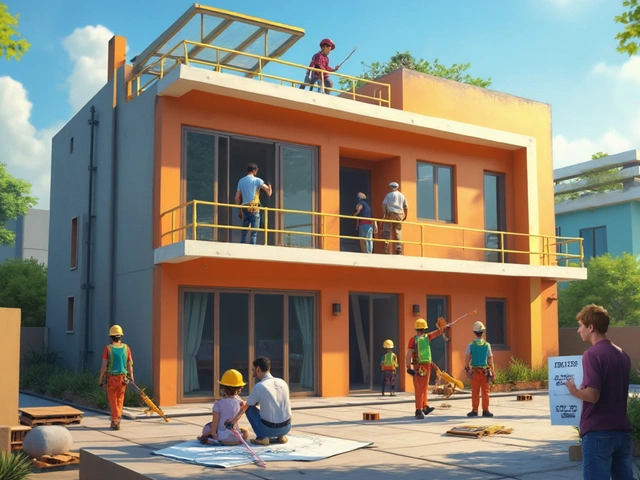Thinking about turning your loft into a shiny new bedroom or office? On paper, it sounds genius—more living space without the pain of moving. But plenty of people get caught off guard by just how many things can go wrong or cost more than planned.
The truth is, loft conversions come with their own set of headaches. Before you start knocking out ceiling beams, you need to know about hidden costs, rulebooks thicker than your smartphone, and the annoying surprises that even the best builders sometimes fail to mention. Want to avoid a roof that's colder than your spare fridge, or fights with neighbours about blocked views? It's all about knowing what to expect from the start.
- Hidden Costs and Budget Surprises
- Planning Permission and Red Tape
- Structural Risks and Building Regulations
- Impact on Living Space and Comfort
- Neighbour Issues and Loss of Privacy
Hidden Costs and Budget Surprises
Most people start a loft conversion expecting a certain price tag, but the final bill often creeps up higher than planned. Your builder’s quote might only cover the basic building work—extras pop up as soon as the real work begins. For example, if your ceiling isn’t high enough, you may need to lower the floor or raise the roof. This isn’t cheap and can run into thousands in added expenses.
There’s also VAT to think about, which most quotes leave out. It’s 20% on top of almost everything, unless your property ticks very specific boxes for reduced rates. If you’re relying on electrics or plumbing for a new bathroom or extra outlets, rerouting pipes or wiring into your loft nearly always costs more than you’d expect. And don’t forget the cost of insulating the loft properly—doing it badly leads to freezing winters and roasting summers.
Another one that people often miss is fixing or upgrading your roof. If your tiles or structure aren’t up to scratch, you can’t just build on top—sometimes the whole thing needs a refresh just to handle the extra weight. Factor in fees for architects, planning applications, building regulation checks, and maybe even party wall agreements if you share a wall with next door. All these extras can add up fast.
Bottom line? Save more than you think you’ll need, and always ask builders for a list of what isn’t included in their price. That’s usually where the big surprises hide.
Planning Permission and Red Tape
Here’s where a lot of folks stumble: thinking their loft project is so simple it won’t need any paperwork. Reality check—making major changes to your property often triggers a pile of rules and forms. In the UK, most loft conversions fall under something called “Permitted Development Rights,” which means you might skip full planning permission if you stay within certain limits. But that only works if you stick to things like keeping your extension below 40 cubic metres (for terraced homes) or 50 cubic metres (for detached and semi-detached houses).
Go bigger, change the roof shape, or live in a flat or conservation area? Expect to fill out some serious paperwork for planning permission. Councils can say no if they think your plans will block light or mess up the look of the street. And the process isn’t quick—sometimes it takes two months or more just waiting for a decision.
There’s more. Even if you dodge planning permission, you’ll need a “building regulations approval.” These aren’t the same thing. Building regs make sure your new loft is actually safe—a proper staircase, fire doors, solid structure, the works. If you try to cut corners and don’t get the right approvals, you could end up with a fine, trouble selling your house, or needing to rip out everything you did.
- Look up your council’s rules before hiring anyone.
- Double-check if your house is in a special area—those rules change fast.
- Get clear advice from a builder or architect who knows current regulations.
Don’t let red tape catch you off guard. A loft project only feels simple if you’re ready for all the paperwork and keep that loft conversion dream legal from day one.

Structural Risks and Building Regulations
Loft conversions put your home’s skeleton to the test. Not every loft was designed to be another living space. What looks like just adding a floor is really about making your entire roof and upstairs structure take on a lot more weight—sometimes a ton or more. That’s why structural calculations matter so much. If your existing beams and joists aren’t up for the job, you risk sagging ceilings or—worse—a bowing roof that could lead to real safety problems.
The UK’s building regulations have a whole chunk dedicated just to this, known as “Part A: Structure.” You’ll also get checked on things like fire safety (Part B), insulation (Part L), and stairs (Part K). Missing any of these can land you in hot water: no completion certificate, problems selling later on, or being ordered to undo all your hard work. Even if planning permission isn’t needed, building regs almost always are. Here’s where loft conversions often trip people up:
- Load-bearing: Most loft floors aren’t built to handle beds, wardrobes, and crowds. You’ll almost always need extra steel beams or deeper joists.
- Fire safety: Building rules get strict. You have to fit fire doors (even downstairs), smoke alarms, and sometimes upgrade walls and floors so fire can’t spread easily.
- Staircases: The new stairs need enough headroom and to be safe—shoehorning them into a tight space isn’t just a pain, it’s often not allowed.
- Insulation: The roof has to be well insulated for energy efficiency. Poorly done, you’ll end up with freezing winters and stuffy summers.
A study by the Federation of Master Builders (FMB) in 2023 showed around one-third of UK loft conversion projects failed building control checks the first time. That means potentially expensive rework, delays, or even ripping things out and starting over.
| Building Reg Requirement | Common Problems |
|---|---|
| Structural Strength | Original joists too weak, cracks in ceilings below |
| Fire Safety | Missing fire doors, poor alarm coverage, risky escape routes |
| Insulation | Cold drafts, condensation, increased bills |
| Staircase Rules | Insufficient headroom, steep angles, unsafe landings |
The best way to dodge these pitfalls? Hire a structural engineer right at the start. Double-check your builder knows the regs inside and out—don’t just take their word for it. And always get sign-off from building control before moving in your new sofa or wardrobe. It’s the difference between a safe, comfy room and a risky, unsellable headache later on.
Impact on Living Space and Comfort
Turning unused loft space into a bedroom or office seems like a great move, but the results aren’t always as cozy or practical as you might think. For starters, many lofts were never designed for full-time living. That means you might end up with sloped ceilings, awkward corners, or rooms where you can’t stand up straight in half the space. That’s not just annoying—it limits what furniture fits and makes even hanging curtains a headache.
The stairway is a sneaky troublemaker. Adding stairs to give loft access usually means stealing space from another room—sometimes a hallway, sometimes a bedroom. That can shrink valuable living areas downstairs. In fact, squeezing in a loft staircase can take away as much as 2 to 3 square meters, according to several renovation surveys.
Comfort is another story. Lofts get cold in winter and heat up fast in summer, even with extra insulation. The heat loss through the roof is a real issue, especially in older houses. A study in the UK found that up to 25% of home heat can escape through the roof if it's not properly insulated. On sunny days, you might wish for air con just to make the room usable.
Noise matters too—especially if you’re adding a bedroom. Loft rooms can let in more outside sounds, like rain hammering on the roof or traffic passing by. Thin party walls and lightweight floors don’t help, as they transmit sound more than traditional walls between floors.
Here’s a quick snapshot to weigh things up:
| Comfort Factor | Common Issue |
|---|---|
| Insulation | Hard to keep warm/cool, risk of draughts |
| Ceiling Height | Sloped walls limit usable space |
| Access | Stairs eat into other rooms |
| Noise | More exposure to rain and outside sounds |
If you want the loft to feel like a proper living space, plan for extra insulation, smart heating and cooling, and check if you’re meeting local building requirements for headroom and natural light. Skimping on any of these steps can leave you with a fancy storage space, not a real room.
And just so you know, the loft conversion might not add as much living comfort as you hoped if these basics aren’t sorted up front.

Neighbour Issues and Loss of Privacy
Add a loft conversion and suddenly you’re a lot closer to your neighbours—sometimes literally. This can be a dealbreaker if your new loft windows give you a perfect view into everyone’s gardens or bedrooms. Don’t be surprised if next door isn’t thrilled about losing their own privacy or feeling overlooked by your new dormer window.
It’s not just about who can see who. There are actual rules (called the Party Wall Act in England and Wales) that kick in if your conversion touches a shared wall. You have to officially notify neighbours, and they can object or ask you to tweak your plans. This can add weeks—or months—to your timeline. A 2023 government report showed that nearly 30% of loft conversion delays come from disputes or objections by neighbours. And while most disagreements get sorted, the extra stress and paperwork can be a real headache.
- If your house is in a conservation area or a listed building, be ready for extra scrutiny and possible flat-out refusals.
- If you’re planning roof terraces or balconies, expect even tougher objections.
- Noisy works can quickly spark complaints, especially when work drags on longer than promised.
Here’s a handy table highlighting some key facts about neighbour issues with loft conversions:
| Issue | Percentage of Projects Affected | Potential Impact |
|---|---|---|
| Neighbour Objections | 30% | Delays, plan changes |
| Privacy Concerns | 28% | Legal changes, frosted glass required |
| Party Wall Disputes | 21% | Legal fees, work stoppages |
What’s the best move? Chat with your neighbours before you even file your plans. Show them your ideas, address their worries, and aim for a friendly agreement. Installing frosted or angled windows can fix a lot of privacy headaches before anyone gets annoyed. For big changes, get advice from a specialist in party wall agreements. It pays to start your loft conversion on the right foot with everyone around you—less stress, fewer surprises, and no shouting over the fence on Sunday morning.




Write a comment